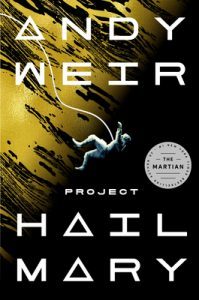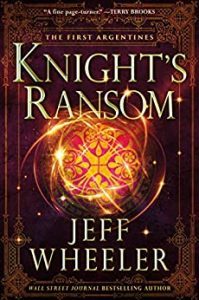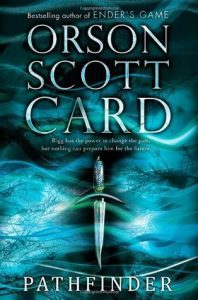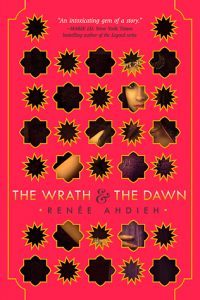C.A. Gray's Blog, page 39
June 25, 2021
Review of Project Hail Mary

I love Andy Weir’s snarky narrative voice. His characters always have more or less the same dry wit, handling personal and global catastrophe with understated sarcasm. Really, this carried the story.
The main character awakens in naked and alone on a cold table covered with IVs and catheters and cannot remember anything about who he was or how he arrived there. Since the whole thing is in first person, he evaluates his surroundings with dry humor, even though there’s nothing funny about the situation at all. He realizes presently that he’s on a space ship, that his only two human companions have been dead so long that their bodies are decomposing, and that he’s being kept alive by a nanny computer. His memory returns to him in flashbacks, which is how we learn his story: he’s Ryland Grace, a high school science teacher, which is part of why he cannot understand how he came to find himself in such a predicament. But the flashbacks fill in the details: the sun was slowly being eaten by an organism that can apparently survive on its surface. Grace has a history in academia, though he left it after being ridiculed for his a wild theory that living organisms may not necessarily be water-based. This is exactly why the scientists scrambling to solve the astrophage problem later sought him out.
It appears that aside from flashbacks, Grace will be the only character in the entire novel (much like Mark in The Martian). But a little under halfway through the novel, he meets an alien in another solar system, there for the same reason he is. I wondered how Weir would pull off an alien encounter without making it impossibly stereotypical and cheesy, but he did a great job. Much of their early interaction involves learning one another’s languages (though since the alien speaks in musical tones impossible for a human to mimic, I did wonder at the shorthand of how Grace actually manage to speak back. Everything is of course translated to English for us so this kind of got glossed over as far as I could tell, unless I missed it. Which I probably did, the rest of the novel is incredibly detailed.)
I loved the frame story; it saved a lot of revelations for Grace and the reader simultaneously as he recalled how he came to be alone on what amounted to a suicide mission. I certainly wondered how the story could possibly end without (again) being too anticlimactic or too predictable, but there was a great twist that I didn’t see coming. Very creative!
My rating: *****
Language: surprisingly little considering how chock-full of cuss words The Martian was. (In fact, Grace himself marvels that he isn’t using swear words in appropriate moments; this later turns out to be because he’s a teacher.)
Sexual content: nothing overt though in flashback there’s some rather humorous allusions to activities of others
Violence: none that I can recall, which is surprising considering the circumstances
Political content: politicized scientific topics were important to the plot. I overlooked that.
The post Review of Project Hail Mary appeared first on C.A. Gray.
June 18, 2021
Romeo and Juliet: A Novel, by David Hewson
Today’s podcast review comes from this blog review of Romeo and Juliet: A Novel.
The post Romeo and Juliet: A Novel, by David Hewson appeared first on C.A. Gray.
June 16, 2021
Review of Knight’s Ransom

I feel like I know the world of Kingfountain and its surrounding nations and lands, after having read so many books set there. I do have trouble sometimes placing the various series in chronological order, though there are usually clues as the story goes on to help. The culture doesn’t seem to change for the most part from one series to the next, though.
This one is set long after King Andrew (Wheeler’s answer to King Arthur), and therefore must also be set long after the Kingfountain series. Even so, Ransom and Claire feel almost exactly like Owen and Victoria Elysabeth Mortimer from that series, and I’m hoping that their stories don’t likewise follow a similar path! Ransom is the nickname of the knight who grows up to be the main character, though he starts out a boy who is more or less orphaned in the house of a king, much like Owen. He’s shy and retiring, though friends as a child with the effervescent Claire. Unlike the earlier pair, these don’t spend nearly as much time together as children, though–they’re separated early on, as Ransom makes his way in the world first by achieving knighthood and then on various escapades as he searches for a lord to serve. Court intrigues influence his choice, while Claire pines for him from a distance and tries to keep herself unattached, despite many seeking her hand.
Toward the end, the story introduces shades of the Arthurian legend repeating itself (this is also one of the themes of the world of Kingfountain: the old tales recur again and again), and also shades of the biblical story of Joseph. I raced through this one as fast as I do all of Wheeler’s series, and will shortly begin the next one!
My rating: *****
Language: none
Violence: fantasy only
Sexual content: none
Political content: none
The post Review of Knight’s Ransom appeared first on C.A. Gray.
June 11, 2021
Review of Romeo and Juliet (David Hewson’s Version)

This was an incredible retelling! I’ve never been great at deciphering Elizabethan English, nor am I especially disposed to try. Hewson did not modernize the setting (it’s set in 1499 Verona, though this is more specific than Shakespeare was), but he did update the language so that it reads like a novel. This was immensely helpful to me both in terms of enjoyment, and also understanding characterization nuances I either never caught before, or that Hewson invented in his retelling. I love his interpretation of Juliet: fiery, headstrong, and a little exasperated with Romeo’s constant poetry. She really seems to drive the whole story. The Nurse is bawdy but loving. Luca Capulet is the one responsible for the ongoing rift between the families, while Sr Montague is just old and tired and has very little passion left in him. The poor friar has the best of intentions, but nothing turns out as he plans. Paris is a lascivious wretch; you can see why Juliet would rather die than be forced to marry him, even had there been no Romeo.
This version also had what I’ll call a surprise ending, though the author’s note explains that Shakespeare borrowed his source material from older writers and did not invent the story of Romeo and Juliet… his version just became the most popular. As I listened I kind of hoped there would be an alternate ending, since I wasn’t sure how much license he was taking. The ending I got still wasn’t the one I really wanted, but it fits with the characters, I think.
Also, I could listen to Richard Armitage read the phone book. What a voice!
My rating: *****
Language: I think there was some but I can’t recall.
Violence: lots of murder and gore, though it could be more gratuitous than it is
Sexual content: present once (marital, between Romeo and Juliet on their wedding night) but quite a bit of vulgar innuendo
Political content: none (historical)
The post Review of Romeo and Juliet (David Hewson’s Version) appeared first on C.A. Gray.
Pathfinder by Orson Scott Card
Today’s podcast review comes from this blog review of Pathfinder by Orson Scott Card.
The post Pathfinder by Orson Scott Card appeared first on C.A. Gray.
June 4, 2021
The Venice Sketchbook, Rhys Bowen
Today’s podcast review comes from this blog review, The Venice Sketchbook
The post The Venice Sketchbook, Rhys Bowen appeared first on C.A. Gray.
June 2, 2021
Review of The Venice Sketchbook

Rhys Bowen seems to have two similar yet different genres, and I’ve come to enjoy both: the witty tongue-in-cheek cozy murder mystery series, and those like “The Venice Sketchbook”: much more serious dramas which are nevertheless still slice-of-life, rich with detail and usually emphasizing a particular form of art. All of her novels are set in WWII Britain and Europe, and they are so episodic that I come to feel like I’m there.
This story followed really one main character, though a second was present just as part of the frame story. Caroline, a newly divorced single mom whose cheating husband took her son and now refuses to return him, using the collapse of the Twin Towers as an excuse (her story takes place in 2001), comforts herself by going to live with her grandmother after the recent decease of her great Aunt Lettie. As Lettie lays dying, she desperately tries to get across to Caroline that she wants her to have a particular box. Caroline roots through it and is perplexed to find a sketchbook inside, and three mysterious keys.
While she has to follow the mystery one piece at a time, the reader learns “Aunt Lettie’s” past interspersed with Caroline’s present, though Caroline does not yet know it herself. Lettie’s real name is Juliet, and she grew up in the era of WWII, where she visited Venice on several occasions. The first time, as a teenager, she met a young man named Leonardo and snuck away from her own overbearing aunt to spend the evening with him. He turned out to be the son of the Da Rossi family, one of the wealthiest and most powerful families in town. Her aunt whisked her away, and she could not even tell Leo goodbye. Ten years later, Juliet is far more disillusioned, working as an art teacher, when she has the opportunity to spend another year abroad in Venice. She jumps at the chance, and encounters Leo again–now betrothed to a woman he doesn’t love, but must marry because of his family connections. Unfortunately this is also the eve of WWII. We see Juliet’s life in Venice at the time in great detail–the art she drew and appreciated, the food she ate, the people she met, and the unsuccessful attempts she made to avoid Leo as their story progresses. The war encroaches closer and closer, and while Juliet intends to go home to England and to safety, circumstances transpire that prevent her best intentions.
Caroline, meanwhile, seems in some ways to mirror her aunt’s story: both of them are estranged from their toddler sons by means outside their control. Both of them are falling in love with Da Rossi men. Both wonder where their lives are headed, and likewise wonder if they can see themselves staying in Venice.
The story ends not exactly happy, but bittersweet. What I loved most about it was actually all the description. I love Europe, and I felt like I was there.
My rating: ****
Language: none
Violence: none to speak of (it was at wartime but nothing gratuitous)
Political content: none (historical)
Sexual content: present once but in a fade-to-black way
The post Review of The Venice Sketchbook appeared first on C.A. Gray.
May 28, 2021
The Wrath and the Dawn, by Renee Ahdieh
Today’s podcast review comes from this blog review of The Wrath and the Dawn.
The post The Wrath and the Dawn, by Renee Ahdieh appeared first on C.A. Gray.
May 24, 2021
Review of Pathfinder

Card’s stories always involve subtle and very creative magic: he tends to choose abilities I’ve never seen done before, and then proceeds to explain them pseudo-scientifically, or at least logically within the framework of the world he creates. I love that about his worlds. This story was quite ambitious, encompassing some eleven thousand years, as well as time travel and diverging timelines. The world wasn’t ours, but he lifted a lot of scientific principles from ours.
Most of the story toward the beginning is told through the eyes of Rigg, a boy who thinks his father is a trader and a hunter, and whose father is exceedingly logical and for some reason seems bent on teaching him nearly everything about the universe, even though from Rigg’s perspective, he’ll never need to know all of it. Rigg has the ability to “see” the paths of every creature that has ever lived, but he doesn’t think of this as seeing into the past at the time. When his father dies, he and a less cultured boy named Umbo from his community set off together on the last errand Rigg’s father ever gave him: to find his sister, and to receive his inheritance. Together, Rigg learns that Umbo also trained with his father to hone his own gift: the ability to slow down time, which has the effect of showing Rigg that what he really sees is the past, sped up and repeated in a never-ending loop. When Umbo slows him down long enough, he can see the individual making the path at the time he made it, even if it was hundreds or thousands of years in the past. Much of the story is spent with the two of them trying to hash out the rules of their abilities and how they work together. Along the way they encounter Loaf, a gruff adult who essentially serves as guide and protector to them. Rigg learns that he is apparently not only royalty, but that he was supposed to have been dead long, long ago. His sister Param, whom he does actually encounter, has the ability to make herself invisible–but they learn through much dialogue that she isn’t actually invisible, she’s just moving so slowly through time that photons cannot strike her body. All the time they refer to the place they live as “Wall,” and eventually they reach “The Wall,” which is supposed to be uncrossable.
In brief interludes, the story cuts to Ram, traveling on a space ship toward a new planet for humans to colonize. Of the humans on board, he alone is awake, surrounded by “expendables,” or robots, who will navigate the rest of the way. Ram is similarly gifted, but he ends up splitting his ship into nineteen parts–nineteen parallel realities. At this point I realized (spoiler alert) that even though Rigg appears to live in a less modern world, and Ram is on a spaceship, Ram is in fact the ancestor of all of them. The Wall blocks off the alternate versions of the human race spawned by the nineteen different ships.
I might say the story gets bogged down by all of the characters’ attempts to understand the rules of their world, but I actually found that to be the most interesting part. Once parallel timelines were introduced I don’t know that I totally followed it all, though. Consequently I may or may not continue the series.
My rating: ****
Language: none
Violence: none
Sexual content: none
Political content: minor
The post Review of Pathfinder appeared first on C.A. Gray.
May 21, 2021
Review of The Wrath and the Dawn

I apparently love retellings — even when I have only the vaguest idea of the original plot.
This retelling was of “1001 Nights,” and I knew roughly that the story was of a bride destined to die in the morning, but she told such great tales each night and left them unfinished so that her husband would let her live until the following night. I looked up the summary of the story when I’d finished to know how much was embellished. It seems there was a very substantial twist in this one.
The king takes a bride every night and kills her at sunrise. The heroine, Shaazi (or Shaarzaad, not sure how to spell that since I listened to it) actually volunteers to be the king’s next bride because her best friend was chosen and murdered, and she seeks revenge. She does employ the traditional ploy to tell intriguing tales which she leaves unfinished, but really that only occupies about two nights. From that point on, she falls in love with the king, and finds that he’s not a monster after all… and yet the girls still died, so instead of enacting her revenge, she instead occupies her time trying to find out what really happened. He falls in love with her too, of course, but there’s a complication: Shaazi has left behind a militaristic boy who loves her, and he comes to find out what she’s learned about the king about 3/4 of the way through the story. Unfortunately he learns of Shaazi’s new and apparently Stockholm-Syndrome-like romance, which presumably inspires the rest of the series.
The romance was necessarily rushed and not terribly believable, and I also had a hard time keeping track of the characters, as they all had names that were unfamiliar to me. I don’t think I’ll read on, but this one did keep my attention through the end at least.
My rating: ****
Language: minimal if at all; can’t recall
Violence: none to speak of
Sexual content: present but very tasteful — mostly it’s a fade to black
Political content: none
The post Review of The Wrath and the Dawn appeared first on C.A. Gray.



